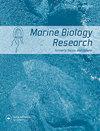黑海的远洋生态系统变成凝胶状
IF 1.2
4区 生物学
Q4 ECOLOGY
引用次数: 0
摘要
本文章由计算机程序翻译,如有差异,请以英文原文为准。
The pelagic ecosystem of the Black Sea goes gelatinous
ABSTRACT Following up on the issue of worldwide growing gelatinous plankton dominance, we analysed historical records on zooplankton biomass from the 1970s to the present, in order to assess the ratio of gelatinous- to-non-gelatinous zooplankton (GN). The latter is poorly analysed in current publications featuring the Black Sea pelagic ecosystem. The GN characterizes the quality of zooplankton as a food source for small pelagic fishes which dominate Black Sea fishery. The retrospective analysis of zooplankton biomass constituents in coastal and open sea waters retrieved from published papers was complemented by an 11-year sampling (up until 2021), across the Crimean shelf. The comparison over regions (represented by the north-eastern, the northern, the north-western, the southern and the open sea) showed that the jellyfish Aurelia aurita, the ctenophore Mnemiopsis leidyi, and the dinoflagellate Noctiluca scintillans act as major contributors to the total gelatinous biomass of the 2000s, on a basin scale. On average, the wet gelatinous biomass is about one hundred times that of the non-gelatinous one. High values of the GN ratio (in wet mass and in carbon units) in coastal waters indirectly imply a leading role of a detritus pathway of organic matter in a pelagic ecosystem.
求助全文
通过发布文献求助,成功后即可免费获取论文全文。
去求助
来源期刊

Marine Biology Research
生物-海洋与淡水生物学
CiteScore
2.10
自引率
0.00%
发文量
55
审稿时长
6-12 weeks
期刊介绍:
Marine Biology Research (MBRJ) provides a worldwide forum for key information, ideas and discussion on all areas of marine biology and biological oceanography. Founded in 2005 as a merger of two Scandinavian journals, Sarsia and Ophelia, MBRJ is based today at the Institute of Marine Research, Bergen, Norway. The Journal’s scope encompasses basic and applied research from all oceans and marine habitats and on all marine organisms, the main criterium for acceptance being quality.
 求助内容:
求助内容: 应助结果提醒方式:
应助结果提醒方式:


